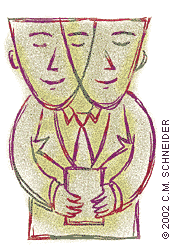
For those days when being a family physician feels more like a burden than a calling, consider this advice from your colleagues.
Fam Pract Manag. 2002;9(8):70

Everyone needs an attitude adjustment occasionally. Many people use their annual vacations for just that purpose, stepping away from daily obligations to reflect on what’s really important. But, as we all know, it can be a long time between vacations. So what can you do in the meantime, especially on those days when the daily grind of practicing medicine is getting you down? We posed this very question to your fellow family physicians. Here’s some of their practical advice:
Use your time in the morning wisely. One physician invested in a television for her bedroom so that she could watch the news and weather as she prepared for her day. What at first felt like an extravagance has become essential in starting her day feeling centered and informed about the world outside her office.
Stop expecting patients to change unhealthy behaviors overnight. Accept patients where they are and try to recognize the small steps they take.
When you are proud of the progress a patient or staff member has made, let it show. For example, offer a heartfelt congratulatory handshake. One physician told us her handshakes are usually accompanied by a “Put her there partner!”
Provide at least one free service a day for someone in need. It can be as simple as doing an ear lavage or evaluating a secondary problem at no additional charge. As one physician told us, “I get discouraged about all the discounting that goes on in medicine, but it gives me a psychological boost to know I can still use my skills to help someone who really needs it but can’t afford it.”
Cultivate new skills. To give your practice a new dimension, add a new skill or procedure each year. Developing expertise in a procedure or area of medicine that is yours alone in your group or community (e.g., travel medicine or acupuncture) can be especially rewarding.
Build relationships with coworkers and support staff. You probably spend more waking hours during the week with your coworkers than with your family and friends, so it’s worth getting to know them.
Fully engage yourself in the office visit. As one physician told us, “I try to remember that although this may be the 100th patient I’ve seen this week, I may be the only doctor my patient will see all year.”
Moonlight occasionally. One physician said he chooses to work several shifts in the ER each month. “Having the knowledge to treat an acute, life-threatening illness helps me to stay on top of aggressive disease management and better care for my patients when they are in the hospital,” he says. “It’s a win-win situation.”
Forget about Musak. Play music you and your patients will actually enjoy in the office, whether it is classical, blue grass or rock.
When taking on a new task or project, eliminate or delegate a current one, no matter how small.
Implement systems to help you and your staff get out of the office on time. For example, one practice processes patient phone calls and requests in “real time” as they come in. This prevents work from piling up at the end of the day.
If you’re feeling isolated, go online for some give-and-take with other physicians. Seek out physicians’ self-published Web sites (“Web logs”), in particular. Medpundit (www.medpundit.blogspot.com) and Family Medicine Notes (www.docnotes.com) are two sites devoted to critiquing medical news appearing in the popular press. As one physician told us, “Responding to other medical bloggers [those who write Web logs] has done a lot to make me think more critically and has helped alleviate the professional isolation that had begun to creep into my practice.”
If, one day, you wake up thinking, “Is this all there is?” about your profession, we hope you’ll consider using one of your colleagues’ tips. Some of the ideas may seem small and simple, but they’ve made a difference in the way other family physicians approach their work.